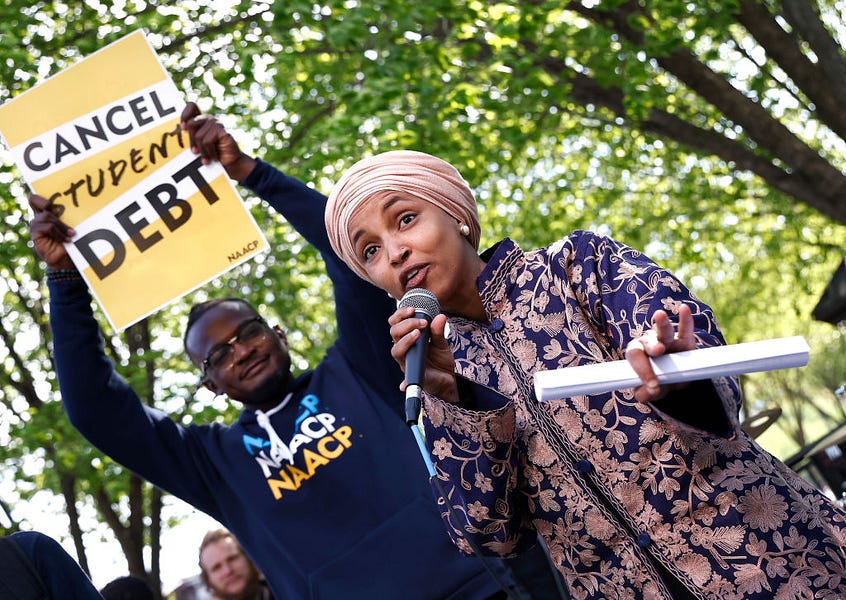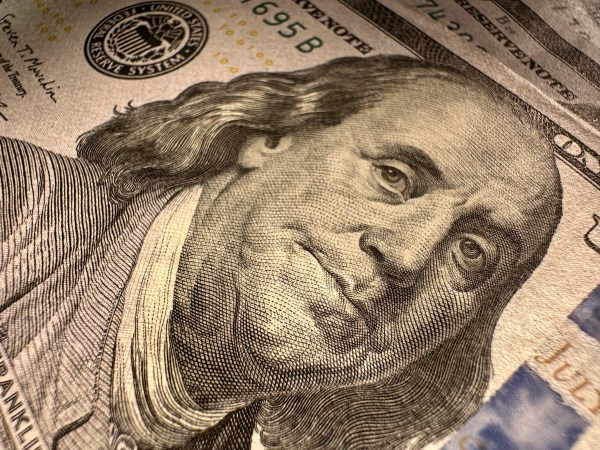President Biden is reportedly weighing an executive order that would attempt to cancel some or all of the $1.6 trillion in federal student loan debt. Leading congressional Democrats have endorsed a full forgiveness of all federal and private student loans. I can relate to these relief demands—my own family will be paying off student loans well into our 50s. Nonetheless, student loan forgiveness would be an unnecessary and destructive policy for the following reasons:
Student Debt is Not a ‘Crisis’
The student loan “crisis” is primarily a manifestation of the progressive bubble—young, urban, college-educated professionals who are dealing with the high cost of rent, child care, and student loans. This includes the legislative and campaign staff of progressive politicians (and sometimes the politicians themselves!), who surely see their own self-interest in framing their personal finances as a crisis. Outside this bubble, student loan repayments are most often a manageable annoyance.
According to education expert Beth Akers, two-thirds of millennials carry no student debt because they did not attend college or were able to avoid loans. Of those who did borrow, the typical student graduates with a $30,000 student loan for a bachelor’s degree that will raise average lifetime incomes anywhere from $1 million to $2.8 million (although these returns vary widely with the major). This is an enormous return on investment. This $30,000 loan with a 4 percent interest rate would require monthly payments of $182 for 20 years, or approximately 4 percent of the typical earnings. Only 6 percent of student borrowers take out more than $100,000 in loans, and they are heavily concentrated in law school and medical school. In fact, 40 percent of all student debt was borrowed for graduate and professional programs, which represent investments in even higher lifetime incomes.
The small percentage of overly burdensome student loans generally consist of: 1) graduates of medical, law, or business schools who can expect much higher lifetime earnings; 2) expensive graduate degree holders in liberal arts fields with an uncertain job outlook; and 3) those who take out loans but never graduate.
Yet, surprisingly, borrowers who take out the biggest loans are not the ones defaulting. Student loan defaults are heavily concentrated among small borrowers ($5,000 or less) whose financial distress was driven by other issues such as medical bills. Attendees of for-profit colleges also have higher default rates.
And Washington has already provided assistance. Borrowers have saved the equivalent of $5,500 (and growing) because of the pandemic-related student loan payment pause, with a total federal cost approaching $150 billion.
The High and Soaring Cost
The Committee for a Responsible Federal Budget (CRFB) estimates that forgiving $10,000 per borrower would cost the federal government $245 billion, while $50,000 in forgiveness would cost $950 billion, and full forgiveness would cost $1.6 trillion. All of these costs would be added to the national debt.
For context, a $1.6 trillion bailout would comprise the largest single federal expenditure in more than 50 years outside of the recent pandemic legislation. It is enough money to eliminate the employee half of the payroll tax for two years, or provide a $12,000 tax rebate to every household.
And that is only the short-term cost. Current loan forgiveness proposals are not accompanied by any reforms to the system that created this mess, which means the same lenders would continue lending under the same terms. Current and future students would likely borrow even more money expecting that it will eventually be forgiven as well (why should only one generation get relief?). This may in turn induce colleges to nudge up tuition more for these less-price-sensitive students.
In fact, even if all $1.6 trillion is forgiven, current estimates show that an additional $1.6 trillion in new student loans would be borrowed in a little more than a decade. We’ll be right back in the same situation, with calls for more debt-financed bailouts, likely pushing up future taxes even further.
It Would Redistribute Income Upward
If Washington is looking to spend $1.6 trillion to alleviate economic hardship, it is baffling to target upwardly mobile college graduates. Nearly half of all student loan debt is held by individuals with graduate degrees—including doctors, attorneys, and MBA business executives—men and women who borrowed as an investment in high future incomes that make the debt affordable. A University of Chicago study cited by the CRFB shows that across the range of loan forgiveness scenarios—from $10,000 per borrower all the way to full forgiveness—the top-earning quintile would receive 30 percent of the benefits, the next quintile would also receive 30 percent, and the bottom-earning quintile would receive just 5 percent (and many of the graduates will rise into higher quintiles over time).
In short, student loan forgiveness would constitute one of the largest giveaways to upper-income families in modern history. Even the 2001 and 2017 tax cuts did not exclude lower-earning families to this extent. There is no justification for a $1 trillion-plus bailout that is disproportionately handed to doctors, lawyers, and business executives.
The Bailout Would Offend Americans as Unjust
The passionate social media debate on student loan forgiveness has exposed an intense backlash from a large group of voters that goes beyond basic fiscal conservatism. Indeed, a large student loan bailout may invite the most intense voter backlash of any federal expenditure since Obamacare.
Beyond being wasteful or unnecessary, a student bailout is seen as fundamentally unjust for four reasons. First, Americans generally believe that debts incurred through voluntary borrowing bring a moral commitment to repay the lender who extended the credit. Second, an individual or corporation that will profit handsomely from an investment should not expect someone else to finance that investment. Third, any bailouts and government assistance should flow down the income ladder, not upward from working class Americans to doctors, lawyers, and business executives.
Fourth, many Americans believe that those who make responsible decisions and (as Bill Clinton famously said) “play by the rules” should not be punished relative to the irresponsible. Forgiving student loans would make chumps and suckers out of all the Americans who paid back their student loans, or worked their way through college to avoid excessive borrowing. Their “reward” for sacrificing to pay off their own student debt (or sacrificing to avoid debt altogether) would be to have the debts of free-loading borrowers dumped in their laps through a higher national debt and likely future taxes. That is government favoritism toward the irresponsible, rather than a level playing field.
Critics retort that we have a moral obligation to throw a life raft to those who are drowning in debt, and that it is selfish to want borrowers to “suffer and sacrifice” just because earlier generations did as well. However, as stated above, college graduates are not drowning. With very few exceptions, they have made an affordable financial investment that will pay off handsomely in future income.
After all, if we have a moral obligation to relieve painful debts, why not start with mortgage debt ($11 trillion), auto loan debt ($1.5 trillion), or credit card debt ($860 billion)? Eliminating those debts would alleviate more suffering for more low-income families than student loan relief. Moving outside debt relief, why not spend those federal funds on health coverage for the poor, or tax credits for working families? Under no standard should upwardly-mobile college graduates be at the front of the line for expensive government assistance.
Debt Relief May Worsen Inflation
During the depths of the pandemic recession, student loan relief was promoted as an economic stimulus to increase disposable income and spending. Yet with inflation raging at 8.5 percent and the Federal Reserve working to constrain economic activity, the same economic analysis would suggest putting the brakes on student loan relief. Extending the student loan payment moratorium is estimated to add 0.2 percentage points to inflation. Democratic economist Lawrence Summers adds that “Wherever one stands on student debt relief this approach is regressive, uncertainty creating, untargeted and inappropriate at a time when the economy is overheated.”
Moreover, many tax experts believe that student loan forgiveness would constitute taxable income, and thus bring a substantial one-year tax bill to many unsuspecting families.
Cancellation by Presidential Order is Likely Illegal
Broad-based student loan forgiveness is highly unlikely to pass Congress. Instead, President Biden is weighing implementing some degree of forgiveness by executive order. Advocates of student loan forgiveness point to language in the Higher Education Act of 1965 that empowers the education secretary to “enforce, pay, compromise, waive, or release any right, title, claim, lien, or demand, however acquired, including any equity or any right of redemption” as permission to waive more than $1 trillion in federal student loan repayments. Critics respond that this section refers only to settling loans on a case-by-case basis, such as in response to lawsuits or liens. It does not grant the executive branch the blanket power to dismiss all of its student loan assets (at a cost as high as $1.6 trillion). Doing so would likely violate the Antideficiency Act, which requires that all executive branch spending first be appropriated by Congress. Thus, courts may strike down any attempt by President Biden to unilaterally forgive student loans.
Distressed Borrowers Already Have Options
Yes, some borrowers truly struggle to make their student loan payments, such as non-graduates and those with expensive graduate degrees in lower-paying liberal arts fields. For those borrowers, federal income-driven repayment (IDR) programs already exist to manage these student loan costs. IDRs generally cap monthly student loan payments at an affordable share of monthly income, and forgive any remaining student loan debt after a period of 10 to 25 years (depending on the specific IDR program). These programs avoid many of the perverse incentives and poor targeting of benefits that broad-based loan forgiveness would create. IDR programs can be unnecessarily complicated and duplicative, so reform-minded lawmakers could aim to simplify these programs and encourage a stronger take-up rate among those truly struggling.
If lawmakers demand a bolder solution, they could consider capping the interest rate on student loans. Alternatively, Beth Akers has calculated that if the goal is to drastically limit defaults, capping loan forgiveness at $5,000 per borrower would achieve that end. The most important reforms would overhaul the student aid process that currently encourages colleges and universities to continually raise tuition to capture new student aid.
For all their rhetoric about combating poverty and inequality, President Biden and congressional Democrats are increasingly trying to steer federal benefits to the professional class that provides much of their party’s votes and campaign funding. There is no policy case for a trillion-dollar bailout of upwardly mobile college graduates, and the political backlash of such a move would likely be swift.
Brian Riedl is a senior fellow at the Manhattan Institute. Follow him on twitter @Brian_Riedl.






Please note that we at The Dispatch hold ourselves, our work, and our commenters to a higher standard than other places on the internet. We welcome comments that foster genuine debate or discussion—including comments critical of us or our work—but responses that include ad hominem attacks on fellow Dispatch members or are intended to stoke fear and anger may be moderated.
With your membership, you only have the ability to comment on The Morning Dispatch articles. Consider upgrading to join the conversation everywhere.